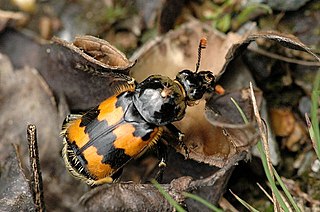
The Integrated Taxonomic Information System (ITIS) is an American partnership of federal agencies designed to provide consistent and reliable information on the taxonomy of biological species. ITIS was originally formed in 1996 as an interagency group within the US federal government, involving several US federal agencies, and has now become an international body, with Canadian and Mexican government agencies participating. The database draws from a large community of taxonomic experts. Primary content staff are housed at the Smithsonian National Museum of Natural History and IT services are provided by a US Geological Survey facility in Denver. The primary focus of ITIS is North American species, but many biological groups exist worldwide and ITIS collaborates with other agencies to increase its global coverage.

Rhamnus is a genus of about 110 accepted species of shrubs or small trees, commonly known as buckthorns, in the family Rhamnaceae. Its species range from 1 to 10 meters tall and are native mainly in east Asia and North America, but found throughout the temperate and subtropical Northern Hemisphere, and also more locally in the subtropical Southern Hemisphere in parts of Africa and South America.

Wildlife conservation is the practice of protecting wild species and their habitats in order to prevent species from going extinct. Major threats to wildlife include habitat destruction/degradation/fragmentation, overexploitation, poaching, hunting, pollution and climate change. The IUCN estimates that 27,000 species of the ones assessed are at risk for extinction. Expanding to all existing species, a 2019 UN report on biodiversity put this estimate even higher at a million species. It's also being acknowledged that an increasing number of ecosystems on Earth containing endangered species are disappearing. To address these issues, there have been both national and international governmental efforts to preserve Earth's wildlife. Prominent conservation agreements include the 1973 Convention on International Trade in Endangered Species of Wild Fauna and Flora (CITES) and the 1992 Convention on Biological Diversity (CBD). There are also numerous nongovernmental organizations (NGO's) dedicated to conservation such as the Nature Conservancy, World Wildlife Fund, and Conservation International.

Arthur Harbour is a small harbour entered between Bonaparte Point and Amsler Island on the south-west coast of Anvers Island in the Palmer Archipelago of Antarctica.

Forficulidae is a family of earwigs in the order Dermaptera. There are more than 70 genera and 490 described species in Forficulidae.

Functional extinction is the extinction of a species or other taxon such that:
- It disappears from the fossil record, or historic reports of its existence cease;
- The reduced population no longer plays a significant role in ecosystem function; or
- The population is no longer viable. There are no individuals able to reproduce, or the small population of breeding individuals will not be able to sustain itself due to inbreeding depression and genetic drift, which leads to a loss of fitness.

The Encyclopedia of Life (EOL) is a free, online collaborative encyclopedia intended to document all of the 1.9 million living species known to science. It is compiled from existing databases and from contributions by experts and non-experts throughout the world. It aims to build one "infinitely expandable" page for each species, including video, sound, images, graphics, as well as text. In addition, the Encyclopedia incorporates content from the Biodiversity Heritage Library, which digitizes millions of pages of printed literature from the world's major natural history libraries. The project was initially backed by a US$50 million funding commitment, led by the MacArthur Foundation and the Sloan Foundation, who provided US$20 million and US$5 million, respectively. The additional US$25 million came from five cornerstone institutions—the Field Museum, Harvard University, the Marine Biological Laboratory, the Missouri Botanical Garden, and the Smithsonian Institution. The project was initially led by Jim Edwards and the development team by David Patterson. Today, participating institutions and individual donors continue to support EOL through financial contributions.

Silpha is a genus of the family Silphidae, or carrion beetles, formerly including several North American species. Members of the genus are sometimes called silphids. All North American silphid beetles are now reorganized in either the subfamily Nicrophorinae, with the only genus in North America being Nicrophorus, and subfamily Silphinae, including the genera Aclypea, Heterosilpha, Necrodes, Necrophila, Oiceoptoma, and Thanatophilus. The genus Oxelytrum is sometimes included due to a dubious Texas record, but to date has never been validated. While members of the genus Nicrophorus typically bury carrion for their larvae to feed upon, members of subfamily Silphinae lay their eggs directly on or in a blown carcass. This is because the larvae not only feed on the carrion, but also upon fly maggots. There are 30 species of silphids in North America North of Mexico.

Blueberries are perennial flowering plants with blue– or purple–colored berries. They are classified in the section Cyanococcus within the genus Vaccinium.Vaccinium also includes cranberries, bilberries, huckleberries and Madeira blueberries. Commercial "blueberries" – including both wild ('lowbush') and cultivated ('highbush') blueberries – are all native to North America. The highbush blueberry varieties were introduced into Europe during the 1930s.

The Euphorbiaceae, the spurge family, is a large family of flowering plants. In common English, they are sometimes called euphorbias, which is also the name of a genus in the family. Most spurges such as Euphorbia paralias are herbs, but some, especially in the tropics, are shrubs or trees, such as Hevea brasiliensis. Some, such as Euphorbia canariensis, are succulent and resemble cacti because of convergent evolution. This family occurs mainly in the tropics, with the majority of the species in the Indo-Malayan region and tropical America a strong second. A large variety occurs in tropical Africa, but they are not as abundant or varied as in the two other tropical regions. However, Euphorbiaceae also has many species in nontropical areas such as the Mediterranean Basin, the Middle East, South Africa, and the southern United States.
Ilybiosoma is a genus of beetles in the family Dytiscidae, containing the following species:

iNaturalist is a citizen science project and online social network of naturalists, citizen scientists, and biologists built on the concept of mapping and sharing observations of biodiversity across the globe. iNaturalist may be accessed via its website or from its mobile applications. Observations recorded with iNaturalist provide valuable open data to scientific research projects, conservation agencies, other organizations, and the public. The project has been called "a standard-bearer for natural history mobile applications."

Silphinae is a subfamily of burying beetles or carrion beetles. There are 113 extant species of this subfamily, in two tribus and in 14 genera.

Oxelytrum is a genus of burying beetles or carrion beetles belonging to the family Silphidae.

Deepin is an open source operating system based on Debian's stable branch. It features DDE, the Deepin Desktop Environment, built on Qt. As of version 15.10 it also uses dde-kwin, a copy of KDE Plasma's window manager. The distribution is praised for its aesthetics in various reviews, while in the past also having been criticized for using a statistical tracking service in its App Store, which has been removed since.

Trogiidae is a family of granary booklice in the order Psocoptera. There are about 11 genera and more than 50 described species in Trogiidae.
Epipygidae is a family of froghoppers in the insect superfamily Cercopoidea. There are at least three genera and about five described species in Epipygidae, found in the American tropics. In addition, there are more than 20 undescribed species in the family.
Colobathristidae is a family of true bugs in the order Hemiptera. There are more than 20 genera and 90 described species in Colobathristidae.
Cryptorhamphidae is a family of true bugs in the order Hemiptera. There are at least two genera and four described species in Cryptorhamphidae.
Malcidae is a family of true bugs in the order Hemiptera. There are at least 3 genera and more than 40 described species in Malcidae.














